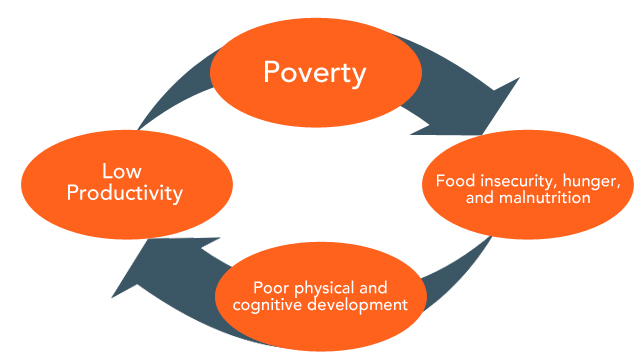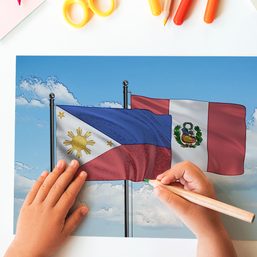SUMMARY
This is AI generated summarization, which may have errors. For context, always refer to the full article.

MANILA, Philippines – More than a quarter of Filipino adults (36%) claimed to be food insecure, while 23% of Filipino children said the same in the latest National Nutrition Survey (NNS) conducted in 2011.
The Autonomous Region in Muslim Mindanao (ARMM) has the highest prevalence of food insecurity. However, the problem is not concentrated in one area, but persistently scattered across all 16 regions of the Philippines.
Some regions may have fewer cases of food insecurity than others. The bigger goal is not to make one Filipino less hungry than its neighbor, but to end hunger for all Filipinos.
What started hunger in the first place?
The 1996 World Food Summit defined food security as the state “when all people, at all times, have physical and economic access to sufficient, safe, and nutritious food that meets their dietary needs and food preferences for an active and healthy life.”
The Food and Nutrition Research Institute of the Department of Science and Technology (FNRI-DOST) calls hunger a severe form of food insecurity. Prolonged hunger may lead to malnutrition, illness, mental and physical growth retardation, among many other complications.
The “ability to acquire acceptable foods in socially acceptable ways” contributes to food security, FNRI-DOST added.
In the Philippines, several households are incapable of the latter. This incapability is seemingly passed on from one generation to the next – permitting a cycle of hunger and poverty.
Not just about food
Hunger, the Food and Agriculture Organization (FAO) explained, is food deprivation. But the issue of food security is not limited to food alone.
Food security has 4 dimensions: physical availability of food, economic and physical access, utilization, and stability. All 4 dimensions must be “fulfilled simultaneously,” according to the FAO.
Aside from the socio-economic status of households, a country’s policies and social services catering to the needs of its citizens are equally important, the FAO said.
These include transportation services, technology, and infrastructure such as paved roads, farm-to-market roads, rail lines, and bridges.
The lack of arable lands and irrigation systems may disrupt the transfer of crops and food products, affecting the livelihood and household food security, especially among farmers and those in rural areas.
The Philippines, a predominantly agricultural country, must pay more attention to the above factors. FAO advised countries to focus on policies that improve the agriculture industry, since “major contributions to food availability come not only from agriculture, but also from fisheries, aquaculture and forest products.”
Food utilization is equally important; individuals must have access to clean water sources and sanitation facilities. To achieve this, one must first have the proper skills and knowledge.
FAO added that the political stability and the absence of violence and terrorism are also indicators of food security. This may explain why conflict-areas are more vulnerable to hunger.
There are two types of food insecurity – chronic (long-term or persistent) and transitory (short-term and temporary).
“Even if your food intake is adequate today, you are still considered to be food insecure if you have inadequate access to food on a periodic basis, risking a deterioration of your nutritional status,” FAO stressed.
Aside from duration, severity of food insecurity is also significant. Severity of undernourishment depends on the population’s dietary energy consumption (in kilocalories), whether it is sufficient or not.
An intricate web

“Simply put, all hungry people are food insecure, but not all food insecure people are hungry, as there are other causes of food insecurity, including those due to poor intake of micro-nutrients,” FAO said.
Another layer to this dilemma is the lack of awareness and information about proper nutrition. Some people may be eating a lot, but this does not mean they are eating well. It is the nutrients that matter. For instance, the 7th National Nutrition Survey from 2008 revealed that 53.8% of Filipinos do not read product labels when buying processed foods.
FAO defined malnutrition as an outcome of either food insecurity, inadequate childcare practices, insufficient health services, or unhealthy environments.
It also clarified the link between poverty and hunger, saying that “while poverty is undoubtedly a cause of hunger, lack of adequate and proper nutrition itself is an underlying cause of poverty.”
Meanwhile, the Organization for Economic Cooperation and Development (OECD) said that poverty “encompasses different dimensions of deprivation that relate to human capabilities including consumption and food security, health, education, rights, voice, security, dignity and decent work.”
What can be done?
To address the issue of vulnerability to hunger, FAO emphasized the need to “reduce the degree of exposure to hazards” and to “increase the ability to cope.” Countries must be ready to address “future threats to food security.”
FAO advises countries to create “safety nets” which can enhance people’s direct access to food. These include:
- Targeted direct feeding programs: for students, expectant and nursing mothers, children under 5 years old, may include soup kitchens and special canteens
- Food-for-work programs: provide food while also “developing useful infrastructure” such as irrigation, roads, health centers, and schools
- Income-transfer programs: in cash or kind such as food stamps or subsidized rations
Attention must be given to those who are “chronically unable to work” due to age, disabilities, or disasters.
What is being done?
In the Philippines, feeding programs are being implemented in selected schools by the Department of Social Welfare and Development (DSWD) and the Deparment of Education (DepEd).
DepEd also advises canteens to provide nutritious meals and to ban unhealthy snacks. Recently, a bill seeking the ban of softdrinks in schools was filed in Congress. The deparment implements nutrition education and Gulayan sa Paaralan, a vegetable gardening program, across schools.

The Department of Health (DOH) promotes food fortification through its Sangkap Pinoy Seal Program, which encourages food manufacturers to fortify products with micronutrients.
Republic Act 8976 or the Philippine Food Fortification Act of 2000 promotes the fortification of staple foods like rice, wheat flour, refined sugar, and cooking oil to “compensate for the inadequacies in the Filipino diet.”
However, not all products are actually being foritified and sold to more consumers.
DOH also conducts Operation Timbang to monitor the nutrition status of Filipino children.
DSWD’s Pantawid Pamilyang Pilipino Program provides cash grants on the condition that families send their children to school and health check-ups. Other DSWD efforts include livelihood and skills training programs, and community gardens, among others.
The National Nutrition Council (NNC) prepared the Philippine Plan of Action for Nutrition 2011-2016, which sets the country’s strategies for achieving its nutrition targets.
Meanwhile, the National Food Authority (NFA) is “vested the functions of ensuring the food security of the country and the stability of supply and price of the staple grain-rice.” However, NFA rice has been at the center of criticism in the past years.
The Nutrition Center of the Philippines (NCP), a non-profit organization, conceptualized Nutri-pan sa Eskwelahan. It establishes bakeries in primary schools and communities selling nutri-pan, bread fortified with iron and vitamin A, at an affordable price. The profits sustain bakery operations. There are over 50 NCP bakeries nationwide.
Non-governmental organizations (NGOs), local government units (LGUs), private sectors, individual donors, volunteers, and local communities are also conducting their own programs in different parts of the country.
In spite of all these efforts, perhaps there is still a need to come up with stronger and more national government-led initiatives and concrete action components to address food insecurity. – Rappler.com
Add a comment
How does this make you feel?





There are no comments yet. Add your comment to start the conversation.